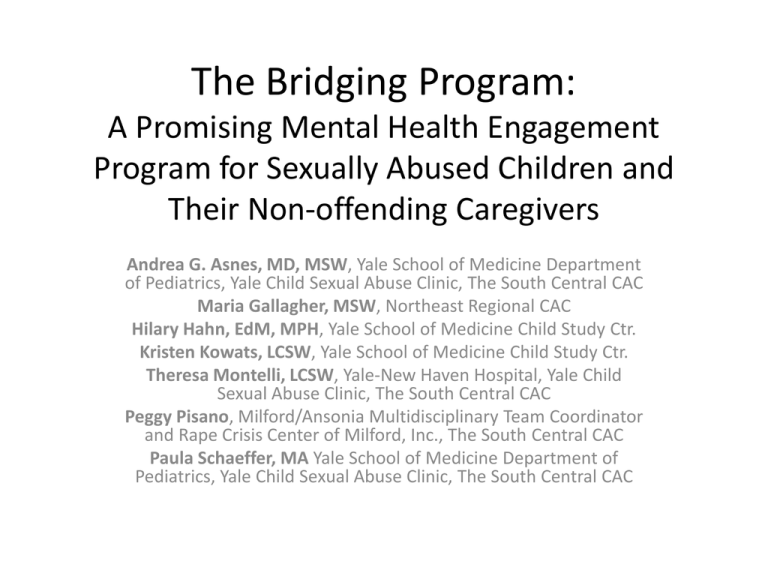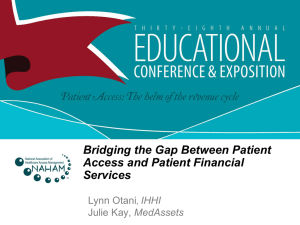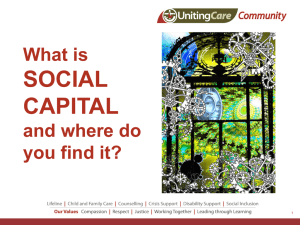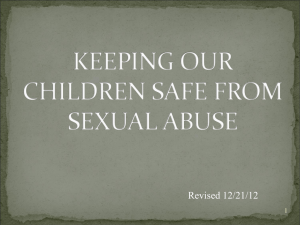The Bridging Program: A Promising Mental Health Engagement
advertisement

The Bridging Program: A Promising Mental Health Engagement Program for Sexually Abused Children and Their Non-offending Caregivers Andrea G. Asnes, MD, MSW, Yale School of Medicine Department of Pediatrics, Yale Child Sexual Abuse Clinic, The South Central CAC Maria Gallagher, MSW, Northeast Regional CAC Hilary Hahn, EdM, MPH, Yale School of Medicine Child Study Ctr. Kristen Kowats, LCSW, Yale School of Medicine Child Study Ctr. Theresa Montelli, LCSW, Yale-New Haven Hospital, Yale Child Sexual Abuse Clinic, The South Central CAC Peggy Pisano, Milford/Ansonia Multidisciplinary Team Coordinator and Rape Crisis Center of Milford, Inc., The South Central CAC Paula Schaeffer, MA Yale School of Medicine Department of Pediatrics, Yale Child Sexual Abuse Clinic, The South Central CAC Goals • WE will tell you the story of our Program and share with you all the things we learned along the way. • YOU will learn from our mistakes and our good ideas. • WE will explain why it takes all seven of us to lead this one workshop. Objectives • Learners will: – Review the barriers to successful engagement in needed mental health services that confront the caregivers of sexually abused children. – Understand the multiple aspects of a successful service engagement program for sexually abused children and their non-offending caregivers. – Explore creative funding strategies that allow for optimal engagement of sexually abused children in needed mental health services. Overview • History of the Bridging Program • Brief description of the Yale Child Sexual Abuse Clinic and the South Central CAC • Description of Bridging referral and engagement strategies • Description of the mental health services provided in Bridging • Description of community involvement in Bridging • Description of Bridging care coordination • Data collection strategies for Bridging • Overview of Bridging data • Overview of Bridging funding strategies • Discussion of future directions Why are there 7 presenters? • This is a team effort. • Collaboration is what it takes to make the program work. History The Problem • Child sexual abuse can lead to multiple downstream negative health outcomes. • One mechanism for poor outcomes is via the development of posttraumatic disorders such as post traumatic stress disorder (PTSD). • Despite the availability of evidence-based treatment, children and families engage in treatment at suboptimal rates (35% of those seen at CACs and referred received services). The Opportunity • Family support is a primary protective factor against posttraumatic symptoms in children exposed to trauma such as sexual abuse. • The forensic sexual abuse evaluation offers a prime opportunity for a targeted engagement effort to link children and families to needed mental health treatment. New Haven, CT 2005 • Well established child sexual abuse clinic serving five MDTs. • Quality community mental health partners with waiting lists and arduous intake processes. • A population of non-offending caregivers who were making it to treatment at suboptimal rates. Non-offending Caregivers • Key element to linking sexually abused children to treatment. • Often in full-blown crisis at the time of forensic evaluation when referrals to treatment are made. • Frequently live in chronically stressed circumstances that may interfere with engagement in treatment. Initial Response to the Problem • We conceived a program that would be a “bridge” between forensic evaluation and eventual mental health treatment. • A holding program to combat waiting lists. • We ended up creating something different. The Collaboration Yale Child Sexual Abuse Clinic + Yale Child Study Center/Childhood Violent Trauma Center + The Salomon Family Foundation = The Yale Bridging Program Request • Make the non-offending caregivers the focus. • Ask how they are before you ask about the child. • Be lovingly aggressive in engaging the family: think infectious disease. • Give lots of chances to make a successful engagement, not just a couple. Key Lessons We Learned Fast • Families need more than mental health treatment: resources and linking between involved services (like schools, child protective services, police, court system). • We can help the other services involved, such as CPS, by providing expert case management services that offer a roadmap to CPS investigators/treatment workers. Description of the Yale Sexual Abuse Clinic and the South Central CAC YCSAC and the SCCAC • Yale Child Sexual Abuse Clinic – Hospital based sexual abuse clinic – Approximately 375 evaluations per year – Participation in 5 Multidisciplinary Teams for Child Sexual Abuse • South Central Child Advocacy Center – Yale-New Haven Hospital, Yale School of Medicine, Clifford Beers Clinic, Rape Crisis of Milford, Department of Children and Families, State’s Attorneys Description of Bridging Referral and Engagement Strategies It starts right away. • Engagement begins with the first contact (usually with forensic interviewer/family advocate and/or MDT or CAC coordinator, but can be CPS or police, too). • The forensic evaluation is also about care and support to sexually abused children and their non-offending caregivers. • This care and support (often very powerful) is the first step. Ideally, it’s co-located, but it is always an immediate and “warm” handoff. • The best scenario is an in person introduction from a known person (like a family advocate) to the mental health provider at the time of forensic evaluation. • If not, a call within 1-3 days of the forensic is crucial. • Best if the known person has mentioned a name to the caregiver(s): “Kristen will call you.” It’s firm, patient and keeps on coming. • Sometimes it takes multiple phone calls, and sometimes the work must start on the phone (telephone engagement McKay). • Sometimes it takes some missed appointments to make it in and that’s okay (think infectious disease). • The “lots of fish in the sea” idea has to be carefully avoided. Sometimes it’s a concrete obstacle. • • • • Transportation. Parking. Child care. Work schedules. Description of the Mental Health Intervention The Child and Family Traumatic Stress Intervention: Early Intervention and Secondary Prevention for At-Risk Children and Youth Developers: Steve Berkowitz, MD University of Pennsylvania Steven Marans, MSW, Ph.D. Yale University School of Medicine CFTSI: What Is It? • Brief (4-6 session) evidence-based early intervention model for children following a range of potentially traumatic events (PTE): – After exposure. – After disclosure of earlier sexual or physical abuse. • Based on a family strengthening approach: – Improves caregivers’ abilities to support children impacted by traumatic events. • Goal is to decrease post-traumatic stress reactions and onset of PTSD by increasing communication and family support. Goals of CFTSI CFTSI aims to: • Reduce traumatic stress symptoms and prevent onset of PTSD. • Improve screening and initial assessment of children impacted by traumatic stress. • Assess child’s need for longer-term treatment. CFTSI: For Whom? • Children aged 7-18 years old. • Identified potential traumatic event(s), either recent or recently disclosed. • Child is experiencing traumatic stress reactions. • Non-offending caregiver (bio or foster) able to participate. CFTSI: Filling a Gap in Available Interventions CFTSI: Fills a gap between acute responses/crisis intervention and evidence-based, longer-term treatments designed to address traumatic stress symptoms and disorders that have become established. Randomized Control Trial: Preliminary Results • CFTSI versus 4-session psychoeducation/supportive comparison intervention. • Sample size = 112 (evenly matched comparison and intervention groups). • Participants recruited from: – Forensic Sexual Abuse Program. – Pediatric Emergency Department. – New Haven Department of Police Service. • Funded by SAMHSA Satisfaction Trends • Youth and caregivers in the comparison group were significantly more likely to feel they needed more sessions beyond the intervention they received (p<.05). • Youth in the CFTSI group felt their experience was more helpful to their family than those in comparison group (p=.06). • Caregivers in CFTSI group felt the intervention helped their children at a higher rate (p=.08). CFTSI in the Child Advocacy Center Setting Change in PTSD Symptoms Following CFTSI (N=134) 25 PTSD Symptom Severity 21.68 20 17.57 15 10.87 9.58 10 5 0 Pre-Tx Parent Post-Tx Parent Pre-Tx Child Post-Tx Child Engagement • • • • • Begins at the forensic interview. Starts with the non-offending caregiver. Flexibility. Collaboration. Overcoming barriers. Format of CFTSI • 4 – 6 Sessions: Individual sessions for caregiver. Individual sessions for child. Joint sessions with caregiver and child. • Each session is 1 to 1 ½ hours in length. • CFTSI focuses discussion on the child’s traumatic reactions, not on the details of traumatic event(s). Mechanisms of CFTSI CFTSI works by: • Improving support by increasing communication. • Providing skills to family to help cope with traumatic stress reactions. • Care coordination and addressing concrete external stressors. Improving Support by Improving Communication • Increases communication between caregiver and child about child’s traumatic stress reactions: – Uses clinical tools to help child communicate about reactions and feelings more effectively. – Increases caregiver’s awareness and understanding of child’s experience. • Provides skills and behavioral interventions to help children and families cope with trauma reactions. Developmental Focus • Providing a developmental perspective, CFTSI helps caregivers to better understand their children’s reactions: – Find the most useful ways of communicating with their children. – Find the best ways of being supportive without being intrusive. • Approach for Young Children Care Coordination and Addressing External Stressors • Care Coordination: – Multi-disciplinary Team. – Additional provider’s in the child’s life. • Addressing External Stressors: – Goal: • To decrease concrete needs that interfere with caregiver’s ability to attend to and support child. • To link family to services that may provide support to adults and other family members. Description of Community Involvement in Bridging The CAC and the MDT • Bridging must be at the table: – Individual case assistance. – General expert advice around trauma-exposed children. – Sustained buy-in from all community partners (it’s a person, not a program). – Opportunities to intervene and help are identified around the MDT table. Bridging and Victim Advocacy • They are not the same thing. • Victims’ advocates have special knowledge about navigating the legal system that is crucial to share with families. • Communication between the Bridging clinician and an assigned victims’ advocate is key. • Simultaneous service delivery in concert is the goal. Bridging Care Coordination Doing what needs to be done. • • • • • • Collaborating with Child Protective Services. Collaborating with Developmental Services. Collaborating with schools. Addressing material resource needs. Interfacing with adult service providers. Sometimes helping siblings and other family members. Bridging Data Collection Strategies Bridging Data Strategies • Engagement: • Collaboration with other individuals and agencies who provide services to children and non-offending caregivers. • Rates of engagement in the Bridging program. • Completion of treatment/intervention. • Referrals/expert assessment. Bridging Metrics • Documentation of time and effort dedicated to engagement: – this can be more time-consuming than the actual appointments. • To document this effort we track the: – number of attempted contacts to non-offending caregivers. – number of successful contacts to non-offending caregivers. Bridging Metrics • Documentation of collaboration efforts between clinicians and other individuals and agencies within the community. • To document this effort we track the: – number of attempted contacts with other individuals and agencies within the community. – number of successful contacts with other individuals and agencies within the community. Bridging Metrics • Engagement/completion/referral outcome data: – – – – – – – – never responded to phone calls. never made an appointment. refused treatment. did not show for appointment. began treatment but did not complete treatment. only needed telephone assistance. completed treatment or intervention. required additional referral at the close of treatment/intervention. Bridging Data 2011 Data 94 Total Referrals 86 (91%) Initiated Treatment/Services 75 (80%) Completed Treatment/Services 55 20 Received Treatment/Services Received Phone Consultation 11 Failed to Complete Treatment/Services 8 (9%) No Show/Refused 2011 Data • Of those 55 families who received treatment/services: – 27 (49%) received a referral for additional treatment. – 28 (51%) did not require additional treatment after Bridging. Bridging Funding Strategies Only a portion of what Bridging is can be billed to third party payers. • What can be billed should be billed. • The additional cost for clinician time can be covered: – By CPS (as it is in CT). – By grant funding (especially to meet shortfalls in funding as occurs when a family is not CPS involved). Bridging can be cost saving • Short term treatment but also expert assessment. • This means that we know what children and families need after Bridging: – Some are done. – Some need trauma focused treatment. – Some need other treatment. • Knowing what’s next is cost saving. Funding should be designed to reflect collaboration. • Consider a strategy that ensures all important constituents are involved in planning and execution of program activities. • Co-writing grants lends strength to applications. • Shared data can be more powerful to funders as well. Future Directions Longitudinal Care • Children seen in Bridging as victims have returned to our CAC as alleged perpetrators. • We know that child sexual abuse is a chronic morbidity that can have lifelong consequences. • How do we follow children and families after Bridging? Some possibilities… • Scheduled check-ins with families: – Yearly? – At key developmental milestones, like puberty? • In coordination with pediatric primary care providers: – Shall we be focusing more on this resource? Bridging Program Components 1. Immediate referral to services. 2. Intensive engagement efforts. 3. Evidence-based, caregiver-inclusive, trauma focused assessment and short-term treatment. 4. Optimized community collaboration evidenced by strong linkages to multidisciplinary teams and victim and family advocacy. 5. Expert care coordination. Key take home points • Think infectious disease. • Build a model that reflects a commitment to collaboration. • Be ready to highlight the long term savings that can result from up front costs. • Advocate for the value of the work that occurs outside the therapy room. Questions? Discussion? Suggestions? andrea.asnes@yale.edu








